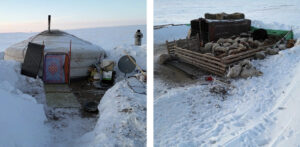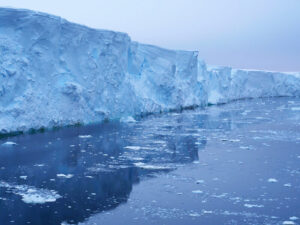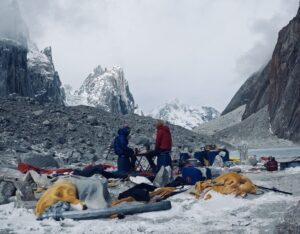Who is to blame for the piles of garbage on K2 and what is being done to clean up the mountain?
Even as the photos of abandoned tents and piles of, well, crap appeared online, a cleaning campaign had begun. A team from the Central Karakoram National Park (CKNP) waited for all the climbers to descend before climbing up to retrieve most of the garbage and old ropes from the higher camps. From July 19 to August 18, they collected 1,610kg of refuse between K2 Base Camp and Camp 4.

The garbage from higher camps was gathered, weighed, and packaged up in Base Camp. It was then transported to an incinerator in Askole. Photo: CKNP
Pakistan’s drinking water
CKNP ecologist S. Yasir Abbas Rizvi told ExplorersWeb that keeping the mountains clean is a matter of individual responsibility for each climber. It’s not just that Camp 2 looks disgusting. It’s about irreparable damage to the fragile glacial ecosystem.
The Karakorum is home to endangered wildlife and many human communities. Remarkably, it also provides drinking water (from the Baltoro, Biafo, and Hispar Glaciers) for virtually the entire country of 221 million inhabitants.

Some of CKNP’s K2 cleaning team last month. Photo: CKNP
Yasir Abbas is central to the current cleaning campaign, but since 2008, his work at the CKNP has a wide scope. He surveys and helps protect wildlife and collaborates with local villages.
“Since 2015, the CKNP is in charge of managing waste in the Karakoram,” he said. “In previous years, we counted on the job done by several NGOs and cleaning expeditions. The main problem is the huge area we have to cover. The approach trek to K2 alone includes 62km of glacial terrain.”

Photo: CKNP
The CKNP is also in charge of collecting fees from climbers, which varies depending on the activity and area. For foreign K2 expedition members, the fee is $200.

More garbage than ever
“Last year, which was a relatively quiet season, we collected 14,200kg [of garbage] between the Baltoro and the 8,000m base camps. This year, we’ve retrieved 20,000kg.”
The CKNP counts on a 15-person team to collect the garbage. However, not everyone is fit enough to climb K2 to clean it.
“We had to hire proper climbers, people capable of being at high altitude and in bad weather,” Yasir Abbas said. “After the reports appeared in the media, we asked them [the hired climbers] to focus first on Camp 2 and then on Camp 1 and Camp 3. The team reached most of the way to Camp 4. We also tried to retrieve as many old ropes as possible.”

Old ropes and oxygen canisters on the slopes of K2. Photo: CKNP
This year, the situation in Camp 2 was especially bad because of high temperatures. Part of the snow cover melted and exposed garbage that had been accumulating for years.

Old crampons, several years or even decades old. Photo: CKNP
The number of visitors to the CKNP is growing every year. “We have installed trash bins and portable toilets along the Baltoro and in Base Camp,” said Yasir Abbas. “And there is a new incinerator in Askole. As for the K2 expeditions, all we ask is for them to bring their garbage down to Base Camp. We will take charge of it from that point. We will carry it the 100km to Askole for incineration. But the climbers must at least do that job [bring it down].”

An updated list of visitors to Pakistan’s mountain areas. Askole, the gate to Baltoro’s 8,000’ers, is the most popular attraction. Source: Yasir Abbas/CKNP
Investigation and punishment ahead
Meanwhile, the Gilgit-Baltistan government has called for an investigation into who left the garbage.

Abandoned tents were found by local climbers hired by the CKNP during the cleaning campaign. Photo: CKNP
“All irresponsible tour operators [should] be blacklisted and denied future trekking permits,” the notice said. You can read it in full below.

The document issued by the Gilgit-Baltistan government.
A caution to foreign cleanup expeditions
Abbas also told ExplorersWeb about a “surprising” post recently shared on Instagram by Nirmal Purja. Purja announced plans for a cleanup campaign on K2 next year, run by his Nimsdai Foundation, and asked for donations to support it.
“No foreign organization is allowed to carry out cleaning campaigns in CKNP boundaries of Gilgit-Baltistan, including on K2, without prior agreement and permission in writing from local authorities,” Abbas said. “Mr. Purja also posted something similar last year but has never asked for permission or even consulted with CKNP or local authorities.”
Many have donated to the Nimsdai Foundation since the announcement. However, the post also faced a backlash from the international climbing community.
Poland’s Janusz Golab is currently on his way with Andrzej Bargiel for a no-O2 climb of Everest (and Bargiel’s ski descent). Says Golab, “In [Purja’s] video, you can see that these are tents from the agencies. Agencies take quite a lot of money for garbage disposal, and now they reach for more money to clean up after themselves? Very interesting.”
Struggling for a clean Karakoram
Climbers consulted by ExplorersWeb confirmed that there are some toilet barrels installed at Concordia but they need better maintenance. At K2 Base Camp itself, expedition teams install their own latrines.

Garbage properly packed and ready to be carried from K2 Base Camp this year. Photo: CKNP
In a previous interview with ExplorersWeb, Flor Cuenca of Peru criticized the state of higher camps, with years of accumulated garbage.
“Some companies do their job and carry garbage down, others don’t,” she said.
Cuenca is not aware of the work done by each outfitter. But she did witness Imagine Nepal, 8K, and Pioneer Expedition piling their garbage in Base Camp, ready to be carried down the valley. She is concerned, however, that previously at some base camps, the garbage was burned on the spot or thrown into crevasses instead of carried out.
Taiwan’s Grace Tseng and Fish Tri shared a number of posts about the garbage on social media and tried to gather some from higher camps. But with so much around, there is not much they could do.
The terrain is difficult and the available resources are scarce. Pakistan is currently facing the worst floods in years, and most resources are understandably focused on this emergency rather than on the mountains. This makes it even more important for climbers to assume responsibility to slow down the decline of the areas they depend on.






